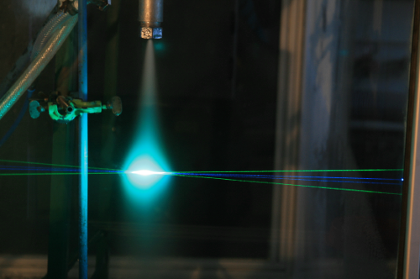Investigation of Reagent Injection in SNCR Systems of Biomass Fired Combustion Facilities using Computational Fluid Dynamics
In this work, the injection of SNCR reagents in a stationary fluidized-bed combus-tion boiler was studied. The emphasis was laid on the development of a simulation model capable to describe the processes of reagent injection and subsequent release of the reactive species within the flue gas flow. Therefore, the spray characteristics of the present nozzle setup were evaluated experimentally using Phase-Doppler-Anemometry, yielding data for droplet size distributions as well as the droplet velocities in the spray cone. The results of these measurements were used to generate sound boundary conditions for the simulation setup as well as to validate the CFD-models.

SNCR-nozzle in operation, laser beams (two wavelengths for two velocity components)
The specific vaporization characteristics of the injected ammonia-water-solution were accounted for by implementing a multi-component evaporation model considering the non-ideal behavior of the present solution. Using this extended evaporation model, the release of substances relevant for selective reduction of nitrogen oxides in the flue gas were investigated.

Experimental results on horizontal sampling surfaces: Axial droplet velocity. Left: 100mm, Center: 150 mm, Right: 200mm distance from orifice.


